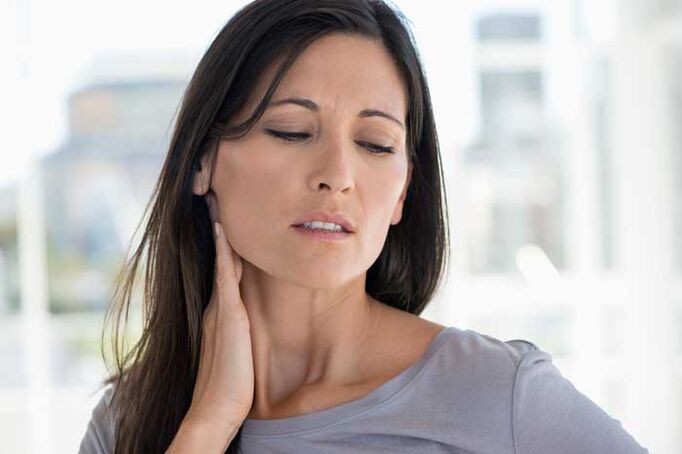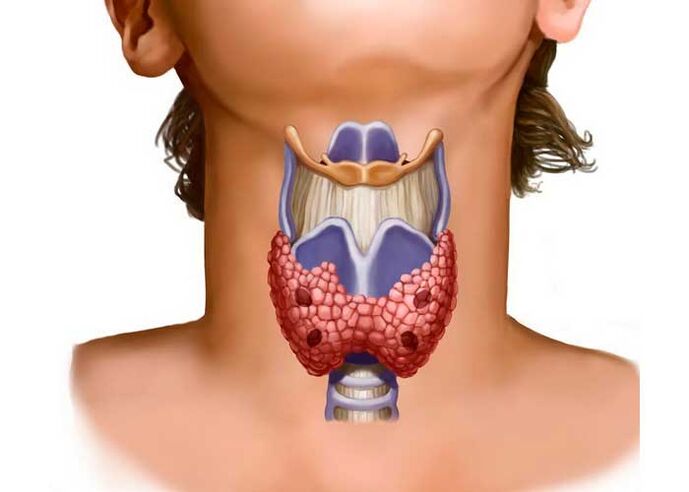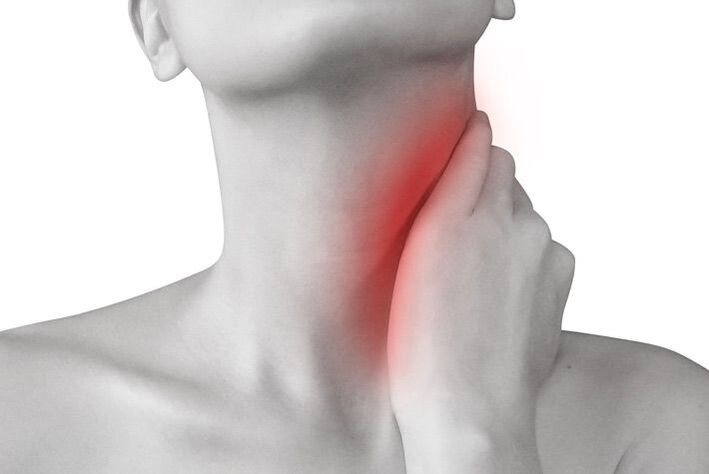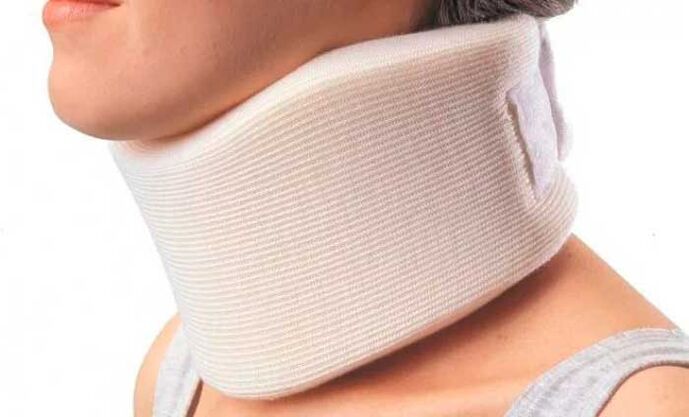
The neck is considered to be the part that determines the life of the human body. The main blood arteries, veins, capillaries and nerve fibers pass through it, forcing the whole body to work fully. Blood channels provide the brain with the distribution of nutrients and oxygen, without which the most important organ of the nervous system cannot function normally. If a person has neck pain, you should look for the causes of the disorder and, as much as possible, eliminate them.
Types of neck pain
Pain syndrome is divided into two main groups:
- Cervicalgia (lumbago) - regularly, with different strength and dynamics, spreads to the shoulders and beyond. Often she has an attractive, hurtful character. The cause is painful spasm of the neck muscles.
- Cervicago is a sharp pain that appears suddenly during sudden sharp turns of the head, a long stay in an uncomfortable position. At the same time, a person is unable to freely turn his neck, napping due to severe pain. "Shoots" in, shoulders, chest, hands. This pain is associated with the effect of stimuli on nerve endings that go near the brain.
Causes of the disorder
Often patients have cervical pain. Sometimes spasm is given in the spine due to unintentional movements of the head. Occasionally, there is discomfort in the occupational region. It is especially uncomfortable when the pain syndrome appears in the morning due to an uncomfortable posture during sleep.
With the combination of unfavorable circumstances, pain can arise due to the consequences of untreated infectious diseases. They are so impatient that it is impossible to think of a reason for their appearance.
Neck pain occurs for a variety of reasons:
- Not specific.
- Vertebrogenic.
- In case of dysfunction of internal organs.
- With the development of oncological formations of benign and malignant nature.
- In case of injury.
- With inflammation of bone tissue (subacute osteomyelitis, purulent lymphadenitis, spinal paralysis, meningitis, worsening thyroiditis).
Non-specific reasons

Patients often have to experience non-specific pain. They arise in response to excessive strain on the cervical muscles and are considered a natural reaction of the body. Usually, this feeling occurs when a person is lying in an uncomfortable position for a long time or is physically overloaded.
Neck pain from serious loads of a dynamic nature. To get rid of unpleasant sensations, the body needs to have a good rest. This pain is not very intense, does not last long and goes away on its own without requiring special treatment.
When the overload is constant, the physiological pain takes a chronic form - a degenerative-dystrophic process begins. Harmful factors should be eliminated immediately when alarming symptoms appear and do not wait for the disease to develop.
The statistical cause of pain can be:
- Wrong position during sleep.
- Frequent head movements.
- Strong high cushion.
Vertebral causes

Dysfunction of the cervical vertebrae, discs, ligaments, ligaments and muscles is the answer to the question of why the neck hurts. When pain syndrome is constantly observed, degenerative-dystrophic diseases of the spine are recorded in such patients during X-ray examination. The neck is susceptible to this disease due to its anatomical structure:
- Neck ties are extremely mobile.
- The beads have a very fragile structure and small size.
- They endure heavy loads every second, supporting the skull.
- Neurovascular fibers are located inside the vertebrae.
Degenerative-dystrophic pathologies include:
- Osteochondrosis.
- Kifoza.
- Spondylolisthesis (list).
- Lordoza.
- Spondylopathy.
- Spinal stenosis.
- Intervertebral hernia. It hurts the neck, mostly on one side.
With such disorders may appear complications in the form of torticollis, disc elongation, compression of spinal cord tissue, progression of sciatic nerve pain, spinal deformity, persistent headache, dizziness and tinnitus.
Internal problems

Neck pain that appears in the front is accompanied by a dysfunction of the thyroid gland. They usually manifest in inflammatory lesions of the gland (thyroiditis), have an acute, subacute, chronic or autoimmune nature. The disorder is indicated by:
- Increases in body temperature.
- Lethargy, drowsiness.
- Redness, possibly swelling of the skin on the front of the neck.
- Choking, difficulty swallowing.
Thyroiditis causes systemic throbbing pain. It grows during swallowing, turning the head, examining the gland.
Sudden neck pain on the side signals inflammation of the lymph nodes in diseases of the ENT organs. Provocateurs of this condition can be:
- ENT diseases of a different nature (pharyngitis, larynx, sinusitis, otitis media).
- Dental caries.
- Gum disease.
- Retropharyngeal abscess.
- Diseases of an infectious nature.
The neck may swell visibly, losing its shape. The temperature rises rapidly, symptoms of the development of the underlying disease are observed.
Development of oncological neoplasms

Neck pain provokes cancer of the vertebral tissues, blood vessels and internal organs located in the neck. Spinal tumors can be:
- Primary (mesenchymal chondrosarcoma, osbolitosarcoma, lymphangioma).
- Secondary (myeloma, lymphogranulomatosis).
It happens that the causes of neck pain lie in tumors of the spinal cord and nerve fibers.
Neck injury

The back in the neck area is quite fragile and vulnerable, which means that it is prone to injuries of varying severity, like p. sh.
- Fractures, lumps, bruises.
- Dislocations, subluxations.
- Variation, rupture of ligaments and muscles.
- Disruption of the intervertebral disc fragment.
- Multiple hematomas, bruising.
- Compression of spinal cord tissue.
Neck injuries are extremely dangerous. This area contains important centers that allow the functioning of the spinal cord. The impact of the brain on the level of segments 1 and 2 of the cervical vertebrae leads to immediate death. Injuries to the lower segments can leave a person unable to feel his body down his neck and move. Trauma of the 7th and 8th vertebrae affects the lower extremities.
Bone inflammation
The cervical spine may suffer from inflammation. Often they are in the nature of systemic connective tissue diseases:
- Limban-Sachs disease.
- Rheumatoid arthritis.
- Periarteritis nodosa.
- Wagner's disease.
- MCTD (Sharpe syndrome).
- Progressive systemic sclerosis.
- Vasculitis.
- Ankylosing spondylitis
When the patient's neck aches and hurts, the causes are often associated with ankylosing spondylitis (ankylosing spondylitis). In this case, the vertebral joints become inflamed, deformed, and complete immobility of the cervical vertebrae occurs.
Neck pain in a child

In children, unlike adults, cervical pain is not hidden in damage to vertebral tissues and structures, but in:
- Lymphadenopathy.
- Tuberculosis of the bones.
- Zaushnitsa (pig).
- Meningitis.
- Tetanus.
- Pneumonia.
- Retropharyngeal abscess.
- Rheumatic diseases (polarthritis, oligoarthritis).
When a child experiences neck pain and discomfort, it can not be ignored. Consultation with a pediatrician is required, as the causes of this condition can be extremely serious.
Therapies and diagnosis

You can completely get rid of the pain by identifying its root cause. You can relieve painful symptomatic sensations with the following medications:
- Nonsteroidal analgesic and anti-inflammatory drugs.
- Muscle relaxants that relieve muscle tone and spasm.
- Glucocorticoid hormonal agents. They are used to enhance the effect of pain relievers.
- Chondroprotectors are used for a long time to restore cartilage tissue and stop its decomposition process.
- Decongestants, anticonvulsants, antidepressants, vitamin therapy to eliminate chronic pain.
An experienced professional should be involved in treating the disorder. First you need to see a therapist. He, according to the complaints, will assess the general condition of the patient, will tell you why the neck hurts, how to treat the pathology, what irritating factors should be avoided.
Depending on the cause of the disease, the therapist will recommend visiting such close specialists:
- Rheumatologist.
- Orthopedist.
- Traumatologist.
- Neurologist.
- Massage therapist, chiropractor.
- Physiotherapist.
For cervical pain, such research methods are described as:
- General blood test.
- Determination of ESR.
- Examination for rheumatoid factors.
- X-ray of the spine.
- CT and MRI (computed tomography and magnetic resonance imaging) of the spine.
When an adult or child develops neck pain, it could be a sign of osteochondrosis, meningitis, a consequence of stress, or a side effect of taking certain medications. Doctors need to determine exactly why their patient has persistent neck pain.
If, after examination, it is found that inflammation of the lymph nodes has become the main cause of neck pain, they are described:
- UHF.
- Massage of the back and base of the skull.
- Improving gymnastics.
- Medication.
You can not ignore the disease. In the later stages of its development, surgical intervention will be required to open the lymph nodes and clear them of accumulated pus.
Non-drug treatment

The complex therapy strengthens the muscles of the cervix, helps to remove spasms, makes them flexible and elastic, improves blood flow, restores the maneuverability of the cervical vertebrae, prevents the aggravation and development of the disease. To do this, use:
- Physiotherapy.
- Acupressure.
- Manual therapy.
- Physiotherapy.
- Holding the collars with splints.
- Spa treatment.
- Acupuncture.
- Spinal traction.
In the acute period, physiotherapy, massage, gymnastics are not used until the pain subsides. Modern methods of physiotherapy allow you to achieve a successful result without powerful drugs and surgical interventions. Ajo:
- Hilamat Hardware System (Elgos).
- Laser glove therapy.
- Electrophoresis.
Doctors advise patients what to do when their neck hurts. Required:
- Sit up straight, do not bend over when reading, writing, eating.
- The work chair should have an ergonomic backrest.
- Monitor your posture as you walk.
- Sleep on a small orthopedic pillow.
- Rub the neck with prescribed ointments or gels with an analgesic effect three times a day.
- Do self-massage to eliminate pain.
For acute or painful neck pain, you should not:
- Throw your head back sharply.
- Turn often on the affected side.
- Work, read, write constantly in a bent position.
- Abuse of holding a splint collar.
- Sleep on a large, high pillow.
What to do if you inflate your neck

Severe pain in the back of the neck, accompanied by muscle inflammation, occurs with prolonged exposure to currents of cold air. People sometimes complain that they have swollen necks. Doctors call this condition miosis. At the same time, the patient can not calmly turn, lean, throw his head back, his neck hurts a lot.
A doctor will help you get rid of the disease quickly and effectively. Before visiting his office, there are some steps you can take to ease the discomfort and pain:
- The painful area should be lubricated with a warming ointment (usually such ointments have an unpleasant odor and cause a burning sensation on the skin).
- Massage the neck with light light movements.
- Apply dry heat to the inflamed area (wrap yourself in a woolen scarf, stick a towel).
- Try not to make sudden movements.
Do not take painkillers without consulting a doctor. Only a doctor can prescribe them and determine the dose.
Treatment of osteochondrosis of the neck
Neck problems with osteochondrosis are more common than with the lower back. Often, the lower segments of the vertebrae are affected - 5-6 or 6-7. The pain is manifested in the back, shoots in the neck on the left, is felt especially intensely during a deterioration.
Osteochondrosis is a chronic disease, manifested by periodic deterioration, which may have vague symptoms for a long time. For treatment, the patient is prescribed:
- Physiotherapy (hydrotherapy is especially effective for this disease).
- Analgesics.
- Taking non-steroidal anti-inflammatory drugs. It is recommended to drink within 3 weeks. The patient's condition is then assessed and a decision is made on the further use of the drugs in this group.
- Special improving gymnastics.
- Manual therapy.
- Along with conservative medicine, treatment with folk remedies is welcome: creams, compresses, decoctions, infusions, oils and homemade creams.
If it would be possible to get rid of osteochondrosis in the early stages, prevention should not be forgotten to prevent re-development of the disease.
Popular recipes

Neck pain can be eliminated using popular recipes:
- The infusion of a series perfectly relieves inflammation. For the medicine, 1 tablespoon is required. l. dry raw materials, filled with a glass of boiling water. After 3-4 hours of infusion and strain, the drug can be taken half a glass before meals.
- An effective ointment is made from a mixture of cantaloupe, pine buds, eucalyptus leaves, mint and snake root. All ingredients are ground into a powder. Then add 100 ml of boiling water and boil for 4-5 minutes. 75 g of melted butter (vegetables or butter can be used) is gradually added to the juice. The ointment is applied after it hardens. Store in the refrigerator.
- In the same way, you can prepare ointments with plantain leaves, hops, burdock, lavender, marshmallow, dandelion, yarrow.
- An excellent healing composition is possessed by an ointment based on dandelion root, birch buds, planted coriander fruit.
Surgical treatment is used in case of emergency and for strict indications - if complications of vertebral diseases develop, the patient suffers from severe chronic pain that can not be eliminated with conservative treatment for six months. Surgery to relieve neck pain carries great risks. Therefore, as a start, all available treatment methods should be taken to fight the disease.






















